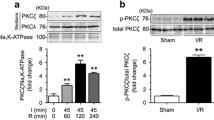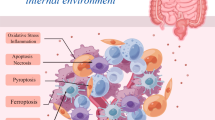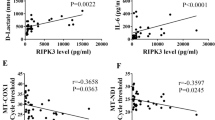Abstract
Intestinal ischemia–reperfusion (I/R) is a serious clinical dilemma with high morbidity and mortality. Remote organ damage, especially acute lung injury and liver injury are common complications that contribute to the high mortality rate. We previously demonstrated that activation of PKCβII is specifically involved in the primary injury of intestinal I/R. Considering the tissue-specific features of PKC activation, we hypothesized that some kind of PKC isoform may play important roles in the progression of secondary injury in the remote organ. Mice were studied in in vivo model of intestinal I/R. The activation of PKC isoforms were screened in the lung and liver. Interestingly, we found that PKCβII was also activated exclusively in the lung and liver after intestinal I/R. PKCβII suppression by a specific inhibitor, LY333531, significantly attenuated I/R-induced histologic damage, inflammatory cell infiltration, oxidative stress, and apoptosis in these organs, and also alleviated systemic inflammation. In addition, LY333531 markedly restrained p66shc activation, mitochondrial translocation, and binding to cytochrome-c. These resulted in the decrease of cytochrome-c release and caspase-3 cleavage, and an increase in glutathione and glutathione peroxidase. These data indicated that activated PKC isoform in the remote organ, specifically PKCβII, is the same as that in the intestine after intestinal I/R. PKCβII suppression protects against remote organ injury, which may be partially attributed to the p66shc-cytochrome-c axis. Combined with our previous study, the development of a specific inhibitor for prophylaxis against intestinal I/R is promising, to prevent multiple organ injury.









Similar content being viewed by others
References
Reino DC, Palanyge D, Feketeova E, Bonitz RP, Xu DZ, Lu Q, Sheth SU, Pena G, Ulloa L, De Maio A (2012) Activation of toll-like receptor 4 is necessary for trauma hemorrhagic shock-induced gut injury and polymorphonuclear neutrophil priming. Shock 38:107–114
Tadros T, Traber DL, Heggers JP, Herndon DN (2003) Effects of interleukin-1alpha administration on intestinal ischemia and reperfusion injury, mucosal permeability, and bacterial translocation in burn and sepsis. Ann Surg 237:101–109
Levy RM, Mollen KP, Prince JM, Kaczorowski DJ, Vallabhaneni R, Liu S, Tracey KJ, Lotze MT, Hackam DJ, Fink MP (2007) Systemic inflammation and remote organ injury following trauma require HMGB1. Am J Physiol Regul Integr Comp Physiol 293:R1538–R1544
Lam V, Su J, Koprowski S, Hsu A, Tweddell JS, Rafiee P, Gross GJ, Salzman NH, Baker JE (2012) Intestinal microbiota determine severity of myocardial infarction in rats. FASEB J 26:1727–1735
Hsieh YH, McCartney K, Moore TA, Thundyil J, Gelderblom M, Manzanero S, Arumugam TV (2011) Intestinal ischemia-reperfusion injury leads to inflammatory changes in the brain. Shock 36:424–430
Tendler DA (2003) Acute intestinal ischemia and infarction. Semin Gastrointest Dis 14:66–76
Matsuo S, Yang WL, Aziz M, Jacob A, Wang P (2013) Cyclic arginine-glycine-aspartate attenuates acute lung injury in mice after intestinal ischemia/reperfusion. Crit Care 17:R19
Horie Y, Wolf R, Miyasaka M, Anderson DC, Granger DN (1996) Leukocyte adhesion and hepatic microvascular responses to intestinal ischemia/reperfusion in rats. Gastroenterology 111:666–673
Cui T, Miksa M, Wu R, Komura H, Zhou M, Dong W, Wang Z, Higuchi S, Chaung W, Blau SA (2010) Milk fat globule epidermal growth factor 8 attenuates acute lung injury in mice after intestinal ischemia and reperfusion. Am J Respir Crit Care Med 81:238–246
Mochly-Rosen D, Das K, Grimes KV (2012) Protein kinase C, an elusive therapeutic target? Nat Rev Drug Discov 11:937–957
Fujita T, Asai T, Andrassy M, Stern DM, Pinsky DJ, Zou YS, Okada M, Naka Y, Schmidt AM, Yan SF (2004) PKCbeta regulates ischemia/reperfusion injury in the lung. J Clin Invest 113:1615–1623
Xu J, Li T, Yang GM, Liu LM (2010) Protein kinase C isoforms responsible for the regulation of vascular calcium sensitivity and their relationship to integrin-linked kinase pathway after hemorrhagic shock. J Trauma 69:1274–1281
Chen Z, Wang G, Zhai X, Hu Y, Gao D, Ma L, Yao J, Tian X (2014) Selective inhibition of protein kinase C β2 attenuates the adaptor P66 Shc-mediated intestinal ischemia-reperfusion injury. Cell Death Dis 5:e1164
Pinton P, Rimessi A, Marchi S, Orsini F, Migliaccio E, Giorgio M, Contursi C, Minucci S, Mantovani F, Wieckowski MR (2007) Protein kinase C beta and prolyl isomerase 1 regulate mitochondrial effects of the life-span determinant p66Shc. Science 315:659–663
Migliaccio E, Giorgio M, Pelicci PG (2006) Apoptosis and aging: role of p66Shc redox protein. Antioxid Redox Signal 8:600–608
Cosentino F, Francia P, Camici GG, Pelicci PG, Luscher TF, Volpe M (2008) Final common molecular pathways of aging and cardiovascular disease: role of the p66Shc protein. Arterioscler Thromb Vasc Biol 28:622–628
Fadini GP, Albiero M, Menegazzo L, Boscaro E, Pagnin E, Iori E, Cosma C, Lapolla A, Pengo V, Stendardo M (2010) The redox enzyme p66Shc contributes to diabetes and ischemia-induced delay in cutaneous wound healing. Diabetes 59:2306–2314
Haga S, Terui K, Fukai M, Oikawa Y, Irani K, Furukawa H, Todo S, Ozaki M (2008) Preventing hypoxia/reoxygenation damage to hepatocytes by p66(shc) ablation: up-regulation of anti-oxidant and anti-apoptotic proteins. J Hepatol 48:422–432
Wang GZ, Yao JH, Jing HR, Zhang F, Lin MS, Shi L, Wu H, Gao DY, Liu KX, Tian XF (2012) Suppression of the p66shc adapter protein by protocatechuic acid prevents the development of lung injury induced by intestinal ischemia reperfusion in mice. J Trauma Acute Care Surg 73:1130–1137
Lane JS, Todd KE, Lewis MP, Gloor B, Ashley SW, Reber HA, McFadden DW, Chandler CF (1997) Interleukin-10 reduces the systemic inflammatory response in a murine model of intestinal ischemia/reperfusion. Surgery 122:288–294
Chiu CJ, McArdle AH, Brown R, Scott HJ, Gurd FN (1970) Intestinal mucosal lesion in low-flow states. I. A morphological, hemodynamic, and metabolic reappraisal. Arch Surg 101:478–483
Mikawa K, Nishina K, Takao Y, Obara H (2003) ONO-1714, a nitric oxide synthase inhibitor, attenuates endotoxin-induced acute lung injury in rabbits. Anesth Analg 97:1751–1755
Eckhoff DE, Bilbao G, Frenette L, Thompson JA, Contreras JL (2002) 17-Beta-estradiol protects the liver against warm ischemia/reperfusion injury and is associated with increased serum nitric oxide and decreased tumor necrosis factor-alpha. Surgery 132:302–309
Lei S, Li H, Xu J, Liu Y, Gao X, Wang J, Ng KF, Lau WB, Ma XL, Rodrigues B (2013) Hyperglycemia-induced protein kinase C beta2 activation induces diastolic cardiac dysfunction in diabetic rats by impairing caveolin-3 expression and Akt/eNOS signaling. Diabetes 62:2318–2328
Jing H, Shen G, Wang G, Zhang F, Li Y, Luo F, Yao J, Tian XF (2012) MG132 alleviates liver injury induced by intestinal ischemia/reperfusion in rats: involvement of the AhR and NFkappaB pathways. J Surg Res 176:63–73
Zheng X, Mao Y, Cai J, Li Y, Liu W, Sun P, Zhang JH, Sun X, Yuan H (2009) Hydrogen-rich saline protects against intestinal ischemia/reperfusion injury in rats. Free Radic Res 43:478–484
Giorgio M, Migliaccio E, Orsini F, Paolucci D, Moroni M, Contursi C, Pelliccia G, Luzi L, Minucci S, Marcaccio M (2005) Electron transfer between cytochrome c and p66Shc generates reactive oxygen species that trigger mitochondrial apoptosis. Cell 122:221–233
Nemoto S, Finkel T (2002) Redox regulation of forkhead proteins through a p66shc-dependent signaling pathway. Science 295:2450–2452
Kluck RM, Bossy-Wetzel E, Green DR, Newmeyer DD (1997) The release of cytochrome c from mitochondria: a primary site for Bcl-2 regulation of apoptosis. Science 275:1132–1136
Ustundag B, Kazez A, Demirbag M, Canatan H, Halifeoglu I, Ozercan IH (2000) Protective effect of melatonin on antioxidative system in experimental ischemia-reperfusion of rat small intestine. Cell Physiol Biochem 10:229–236
Allford M, Bew S (2010) Ventricular fibrillation in an ex-premature neonate following reperfusion of ischemic gut incarcerated within an inguinal hernia. Paediatr Anaesth 20:763–766
Zhi-Yong S, Dong YL, Wang XH (1992) Bacterial translocation and multiple system organ failure in bowel ischemia and reperfusion. J Trauma 32:148–153
Grotz MR, Deitch EA, Ding J, Xu D, Huang Q, Regel G (1999) Intestinal cytokine response after gut ischemia: role of gut barrier failure. Ann Surg 229:478–486
Almeida M, Han L, Ambrogini E, Bartell SM, Manolagas SC (2010) Oxidative stress stimulates apoptosis and activates NF-kappaB in osteoblastic cells via a PKCbeta/p66shc signaling cascade: counter regulation by estrogens or androgens. Mol Endocrinol 24:2030–2037
Suzuki YJ, Forman HJ, Sevanian A (1997) Oxidants as stimulators of signal transduction. Free Radic Biol Med 22:269–285
Finkel T, Holbrook NJ (2000) Oxidants, oxidative stress and the biology of ageing. Nature 408:239–247
Papathanassoglou ED, Moynihan JA, Ackerman MH (2000) Does programmed cell death (apoptosis) play a role in the development of multiple organ dysfunction in critically ill patients? a review and a theoretical framework. Crit Care Med 28:537–549
Arany I, Faisal A, Clark JS, Vera T, Baliga R, Nagamine Y (2010) p66SHC-mediated mitochondrial dysfunction in renal proximal tubule cells during oxidative injury. Am J Physiol Renal Physiol 298:F1214–F1221
Seo BN, Ryu JM, Yun SP, Jeon JH, Park SS, Oh KB, Park JK, Han HJ (2013) Delphinidin prevents hypoxia-induced mouse embryonic stem cell apoptosis through reduction of intracellular reactive oxygen species-mediated activation of JNK and NF-κB, and Akt inhibition. Apoptosis 18:811–824
Inagaki K, Chen L, Ikeno F, Lee FH, Imahashi K, Bouley DM, Rezaee M, Yock PG, Murphy E, Mochly-Rosen D (2003) Inhibition of delta-protein kinase C protects against reperfusion injury of the ischemic heart in vivo. Circulation 108:2304–2307
Tanaka M, Terry RD, Mokhtari GK, Inagaki K, Koyanagi T, Kofidis T, Mochly-Rosen D, Robbins RC (2004) Suppression of graft coronary artery disease by a brief treatment with a selective epsilonPKC activator and a deltaPKC inhibitor in murine cardiac allografts. Circulation 110:194–199
Kong L, Andrassy M, Chang JS, Huang C, Asai T, Szabolcs MJ, Homma S, Liu R, Zou YS, Leitges M, Yan SD, Ramasamy R, Schmidt AM, Yan SF (2008) PKCbeta modulates ischemia-reperfusion injury in the heart. Am J Physiol Heart Circ Physiol 294:H1862–H1870
Baiocchi L, Tisone G, Russo MA, Longhi C, Palmieri G, Volpe A, Almerighi C, Telesca C, Carbone M, Toti L, De Leonardis F, Angelico M (2008) TUDCA prevents cholestasis and canalicular damage induced by ischemia-reperfusion injury in the rat, modulating PKCalpha-ezrin pathway. Transpl Int 21:792–800
Wei L, Sun D, Yin Z, Yuan Y, Hwang A, Zhang Y, Si R, Zhang R, Guo W, Cao F (2010) A PKC-beta inhibitor protects against cardiac microvascular ischemia reperfusion injury in diabetic rats. Apoptosis 15:488–498
Sheetz MJ, Aiello LP, Davis MD, Danis R, Bek T, Cunha-Vaz J, Shahri N, Berg PH (2013) The effect of the oral PKC beta inhibitor ruboxistaurin on vision loss in two phase 3 studies. Invest Ophthalmol Vis Sci 54:1750–1757
Tesfaye S, Tandan R, Bastyr ER, Kles KA, Skljarevski V, Price KL (2007) Factors that impact symptomatic diabetic peripheral neuropathy in placebo-administered patients from two 1-year clinical trials. Diabetes Care 30:2626–2632
Tuttle KR, McGill JB, Haney DJ, Lin TE, Anderson PW (2007) Kidney outcomes in long-term studies of ruboxistaurin for diabetic eye disease. Clin J Am Soc Nephrol 2:631–636
Acknowledgments
This work was supported by grants from the Chinese National Natural Science Foundation (No. 81171850, 81372037).
Conflict of interests
The authors have no competing interests to declare.
Author information
Authors and Affiliations
Corresponding authors
Electronic supplementary material
Below is the link to the electronic supplementary material.
Rights and permissions
About this article
Cite this article
Wang, G., Chen, Z., Zhang, F. et al. Blockade of PKCβ protects against remote organ injury induced by intestinal ischemia and reperfusion via a p66shc-mediated mitochondrial apoptotic pathway. Apoptosis 19, 1342–1353 (2014). https://doi.org/10.1007/s10495-014-1008-x
Published:
Issue Date:
DOI: https://doi.org/10.1007/s10495-014-1008-x




